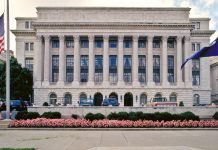Solar growth is outpacing any other type of new energy generation source in Pennsylvania, but local governments may not be prepared to handle these new projects.
A review of the state’s local zoning ordinances by Penn State University’s Dickinson Law School found that 87% of zoning codes provide no guidance on solar developments, said Mohamed Rali Badissy, assistant professor of law at Dickinson.
The preliminary results of the study were discussed during a joint committee hearing on utility scale solar development hosted by Pennsylvania’s Agriculture and Rural Affairs and Local Government committees May 25. The committees heard testimony on the permitting process for local governments.
“It appears Pennsylvania is potentially on the cusp of a boom for renewable energy,” said Sen. Elder Vogel, R-New Sewickley, chair of the ag and rural affairs committee. “Thus it is vital that the legislature explore all aspects to ensure we’re appropriately prepared at the state and local levels of government.”
Solar capacity
There are 11,636 MW in solar projects in the PJM Interconnection queue. PJM Interconnection is the regional electrical grid, said Jason McConnell, PJM director of infrastructure planning, during his testimony. That’s more than all the other energy generation types combined. Natural gas is the next closest with 4,113 MW in the queue.
There’s also 988 MW of energy storage proposed, mostly to go with solar energy or other renewable projects. Not all of the projects in the queue will get built, but it shows a strong interest in putting more solar fields in Pennsylvania.
Ray Fakhoury, government relations consultant with Pattern Energy, testified that his company is developing 600 MW of solar facilities in the state. These projects represent $500 million in investment. Fakhoury said they’re working in Crawford, Erie, Mercer, Adams, Montour, Union, Lebanon and Berks counties.
Government capacity
Badissy testified about the research his team at Penn State Dickinson Law completed on more than 2,500 local zoning ordinances. The results show 13% of zoning codes addressed solar at all, and it was mostly for residential solar energy systems. Only 5% had any guidance for utility-scale solar energy systems.
The lack of regulation might seem like a good thing for developers who don’t want to deal with red tape. But it can actually be a liability and a disincentive, Badissy said.
“The lack of clear regulation is also a significant commercial risk for project developers since they do not know what to expect when seeking a conditional use permit for their utility-scale project,” he said.
Soft costs for lawyers to handle taking a project through an unknown regulatory process add up quickly.
Within that 5%, ordinances had some similarities in setbacks, height and other rules that apply to similar land uses. But there were some big variations, including defining what utility-scale solar is, lot size restrictions and guidance on design and operations, Badissy said. Full results of the research will be published in a few months.
Badissy said it seemed most ordinances came as a reaction to development, instead of a proactive measure. What seems to happen is that a solar project is proposed, and the local government approves a conditional use for that one project. Then a full ordinance is drafted to handle future cases.
“If we are serious about enabling an energy future for Pennsylvanians that is sustainable and affordable, we should be just as concerned with government capacity as we are with solar capacity,” Badissy said.










